Well, maybe a concrete block rather than an actual rock.
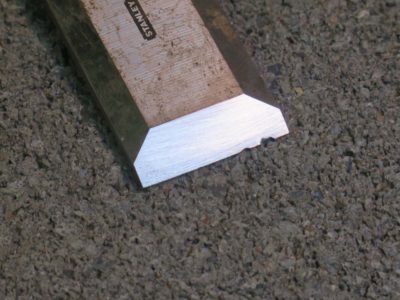
While recently at our daughter’s house I had a trimwork task that required a nice wide, razor-sharp chisel. Unfortunately the only wide chisel I had was this Stanley one I bought from Big Blue for some demo work, and the dentated beveled edge confirms that usage. (This picture was after a minute of working on it, so it was a lot worse when I started out) Were I back in the mountains I would have had no trouble rehabilitating the edge but at that house I only had a fairly fine sharpening stone. So, I remembered a legend from my early days in the trade, when Pop Schindler had to re-cut some joinery while on-site for a project and simply picked a screwdriver from the installation tool kit and sharpened it on the curb to make it into a chisel.
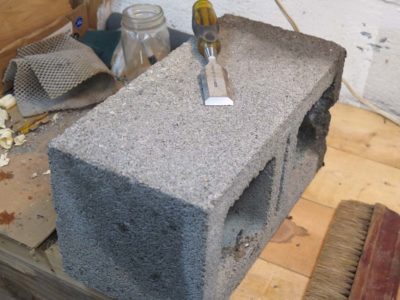

I had the advantage of starting with a chisel, albeit a really beat-up one. Instead of the curb I carried a concrete block into the basement workshop and started working on the edge.
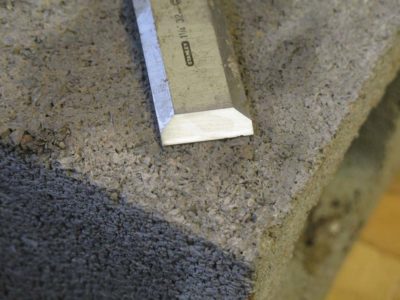
This picture was after about three minutes; after another three or four minutes with the concrete block I had re-established the bevel edge. I did take another few seconds to flatten the back. Like I said, it was a demolition chisel before this.
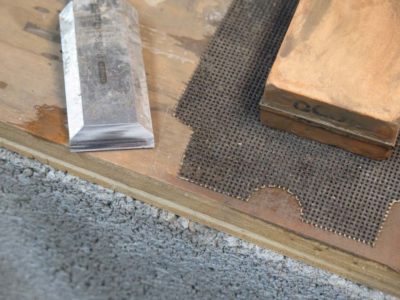
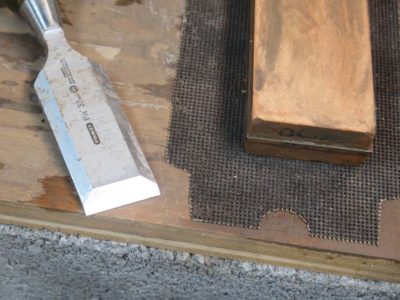
Another minute or two on the water stones and I was up the stairs to trim the door. The chisel notched the vintage cherry trim like it was a hot knife going through butter. My only hurdle was the contortions required to get the tool in the right place to work.
For my palate ultra-dark chocolate transcends mere food or the nutrition pyramid. It is my own version of the mindset often attributed to Ben Franklin, “Beer is proof that God loves us and wants us to be happy.” (I am not of this inclination as I find beer unconsumable. Ditto wine, which tastes like the aftertaste of siphoning gas out of the fuel tank. But mead and rye whisky, those are different subjects altogether.) A great bitter dark chocolate is something to be savored and remembered.
And milk chocolate? A waste of both milk and chocolate. When I bite into chocolate I want it to bite back.
When Barndottir2 got married and moved to North Kor–, er, Northern California we discovered the chocolatery run by her new friends, the Dick Taylor company in Eureka CA. We even went on a factory tour with one of the owners, I forget whether it was Mr. Dick or Mr. Taylor, who was as passionate about his product as we compulsive woodworkers are about a beautifully figured piece of (fill in the blank).
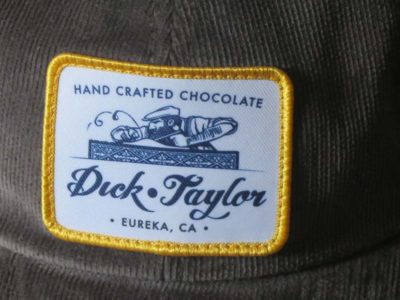
Recently Barndottir2 sent me a hat with the coolest logo ever. The sight of long curls of chocolate shavings erupting from the bench plane practically makes my mouth water. I now have to balance wearing this cap with my desire for making it last as long as possible. If they ever make t-shirts or sweatshirts, put me down for a bunch.
I’m not sure how many of you fully appreciate the remarkable effort of Ralph Boumenot over at The Accidental Woodworker to produce a daily blog for over ten years! He celebrated that milestone on June 16 and has produced a meaty blog post for 3,667 days in a row. That’s roughly 50% longer than Cal Ripken’s streak.
I pat myself on the back if I can get three postings a week, at this point I am only 2300 behind Ralph.
Although he engages in a wide variety of projects in his basement shop Ralph is rightly renowned throughout the woodworking blogosphere for his tutorials on tool restoration. I know I consult his archive whenever I encounter a similar problem, and invariably steer others in that direction whenever I am asked.
Congratulations Ralph, you are an inspiration and role model for us all.

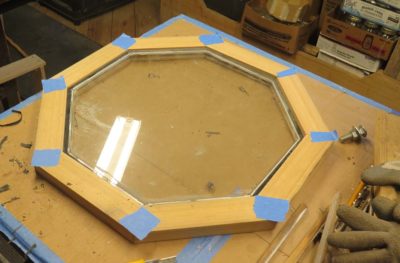
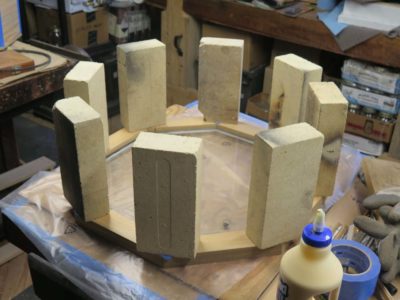
With the basic octagon frame glued and toenailed together I systematically added the inner jamb for the screen and the outer jamb for the tilting window. I moved on to the tilting window frame itself, different only from the unit frame in the orientation of the individual pieces and the cutting of the glazing rebate before assembling everything. None of this was particularly difficult, just some of it was a little fussy. Again the joints were butt miters with waterproof glue and toenailed with my pneumatic pin nailer.

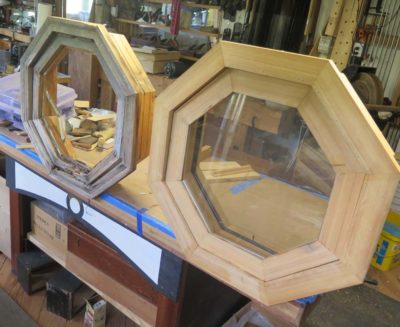
Once I made sure the pieces fit together it was time to add the fascia and start the finishing.

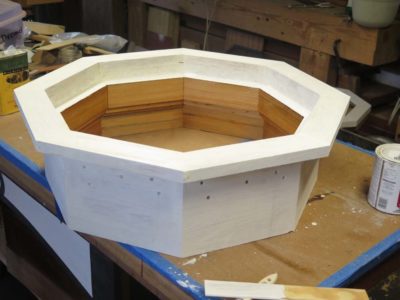
To make sure the window unit was the longest lasting unit I could make I used the old-growth cypress throughout the entire project. That alone should add decades. On top of that every surface had several coatings of finish. The outside surfaces received two coats of primer followed by three coats of acrylic latex enamel. The inner surfaces had three coats of oil-resin varnish applied to them. Oddly enough I must not have thought that the ready-to-install window was worthy of a picture as I did not take one of everything all put together, painted and varnished.


With all the pieces now assembled it was ready to be installed in its new home. The three layers of weatherproofing the original hole in the master bathroom performed well, I am happy to say. I peeled all that off and hoisted the new window on my shoulder and carefully climbed the ladder fervently praying that the fit was good. It was. All it took to install the window was to get the orientation exact and pound it home with a few gently taps from the heel of my fist. A wave of relief washed over me as I did not have to adjust anything.
Now came the truly time consuming part of the project, weaving in the new shingles around the window and the roof fascia. The roof fascia was not removable since the new roof and drip edge were securely fastened to it.
In recent years a mini-bench accessory for the top of a workbench has been all the rage. There are probably more than a dozen featured in Youtube. I’ve built some myself and will start blogging about them next Wednesday, but what about an “under the bench mini-bench?”

A lot of my work when moving down the path of fauxrushi involves small object finishing that is very particular and time consuming, Combining the fussiness of the work with my gimpy knee my preference is to sit down as much as possible. Unfortunately the incompatibility of any of my shop stools with the height of my finishing bench, it was my first Roubo bench, I came up with the idea for a lower workbench like I see frequently in the Youtube videos about urushi work. To serve my needs in this aspect of work I made a pull-out work surface to slide under the top of that Roubo bench. This sliding mini-workbench is a 24″ x 48″ piece of 3/4″ hardwood plywood from Lowes, and it simply rides on a pair of runners screwed to the legs. I added sides to the mini-workbench accessory and a full length cleat in the front so it is extremely rigid. The result is a surprisingly sturdy and spacious platform for me to work away.
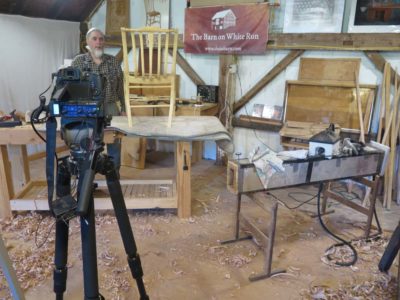
It’s been many moons since Chris and I were able to schedule some time together in the video studio as he has been overwhelmingly busy with a new full-time job, a new old house that needed a lot of work, and a new baby that was born last month in the back seat of the car while on the way to the birthing center. Plus, we’ve all been under house arrest for over three months so there is that disruption. At least my travel schedule has been light; eleven of my eleven teaching/lecturing commitments for the year were cancelled.
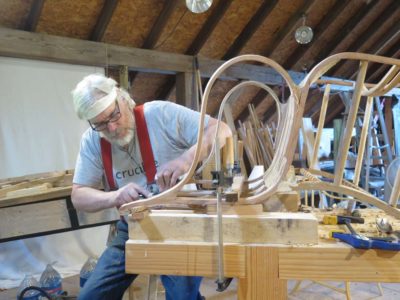
But we are back to planning some video next month, and in the mean time I am trying to wrap up chair #2 to get it delivered to a phenomenally patient client. In order to capture the final piece of the video we need I will actually start another chair and get it to that point of the filming. And, I have penciled in the week after next for my pedal-to-the-medal exercise in building a chair in five days to see if I can schedule a workshop on that project for next year. If that works out and the pandemic has run its course I might offer a Gragg Chair and a ripple molding machine workshop for next summer.
Stay tuned.
Last month my friend Ripplin’ John and I spent a week in the barn working on and brainstorming about our respective ripple molding machines, trying to get a model ready for the show-n-tell of Handworks 2020 (this is before we knew Handworks 2020 was being postponed by the Wuhan Virus). I had made a little progress on my machine since Ripplemania II but he had made great strides with his. During the week his main emphasis was on the lateral “wave” cutting function of his elegant machine while I was simply trying to get my newly designed cutting head to work properly.
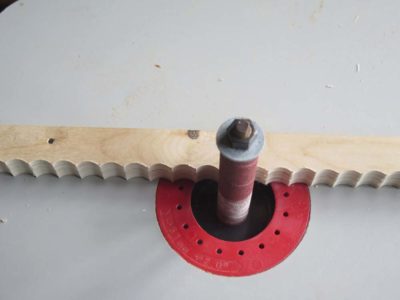
Prior to our most recent week together I had also been working on the notion of improving the method and form of the ripple patterns themselves. I tried a number of different methods and jigs but wound up realizing that precision layout and careful workmanship was the key to producing a crisp, precise concave pattern. Throughout our week we discussed this issue and I am now thinking that concave is not the way to move forward, convex patterns may be the future.
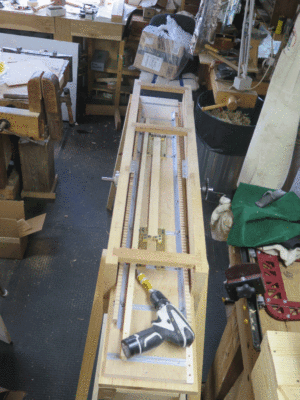
As John was assembling his machine, a fairly lengthy process since it was totally disassembled to fit into hi vehicle, I was puttering on mine.

My new cutterhead was now configured with the cutter being positioned at the end of a long weighted swing arm rather than inside a spring-loaded modulating frame structure.
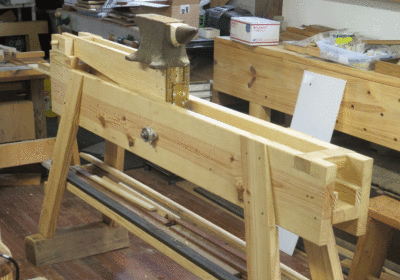
I reasoned that the swing arm was a simpler approach and determined to give it a try. Unlike John I narrowed the scope of my machine to do only one thing, namely cut ripple moldings of approximate 1-1/2″ stock width and 1/2″ thickness. No wider, no thicker. Thus my machine structure was much more restricted than his with approximately zero adaptability.
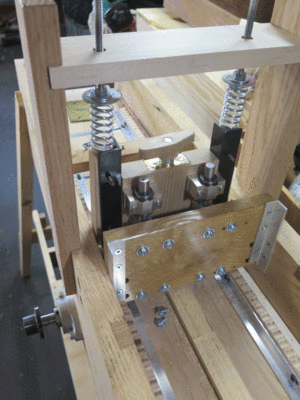
John had been working on two important evolutionary steps. First, the machine could cut but ripple moldings and wave moldings within the same overall machine structure. Second, that the machine could be mechanized and automated thus making it a more practical device for producing large quantities of moldings. As he recited a truth to me, “Turning the platen drive handle gets old after a surprisingly short time!”
I’ll let you know how we progressed next time.
… for my FORP Roubo bench to find its rightful home underneath the bank of northeast-facing windows.
As I’ve mentioned previously the spatial arrangement in my studio has been undergoing reorganization, or as James “Stumpy Nubs” Hamilton calls it, “rearrangeritis.” In one sense I am living with the curse of too much space, thus I need not be particularly efficient with my shop layout nor unduly burdened by the necessity of tidiness. I am trying to improve on both counts.
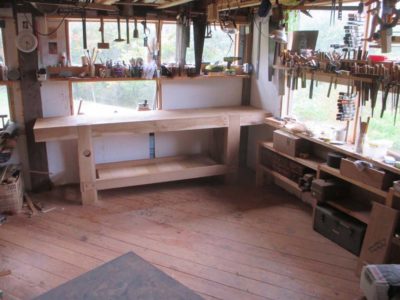

After completing the construction and assembly of my 2013 FORP workbench last year I planted it on the north wall of the shop, thinking that would be a good place.
I was wrong. I back-filled the space around it with my favorite little two-sided workbench and some other stuff and before long the whole space was a chaotic mess.
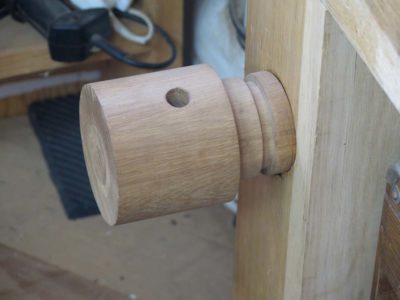
Plus, that new space was so crowded it precluded me even installing the superb wooden screw leg vise that was part of the original design. In the original configuration the four inch round block plus the three inch moveable jaw would have made the whole thing stick out too far to even walk past easily. There simply was no room to use it even if it were installed so it remained on the sideline.
After much cogitation I decided to move it underneath the large bank of windows facing east. This was not done lightly — rasslin’ an 8-1/2-foot, almost 500 pound workbench by myself is not something to undertake on a whim. I set aside a day to move the bench and the other nine things that had to be moved first in order to accommodate the move around the corner, but it was absolutely worth it.
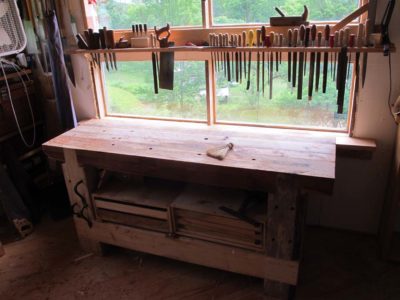
This should not have been a huge surprise to me as it was the location for my first Roubo workbench built from timbers left over from the barn re-erection. Truly, this was THE right location for the bench and I was an idiot for not recognizing this from the git-go.
I now have a sublime arrangement of my beloved first workbench sitting in the middle of the floor at that end of the shop with the Roubo a simple body-rotation away. The arrangement continues to make every day in the shop an unfettered joy.
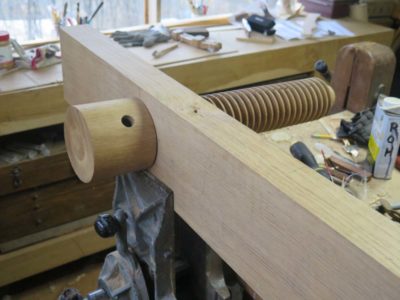
In addition to the move itself I finally finished the installation of the Roubo’s leg vise after first reducing the thickness of the jaw from three to two inches and reducing the size of the bulbous block that was exactly at knee height and stuck way out into the work space.
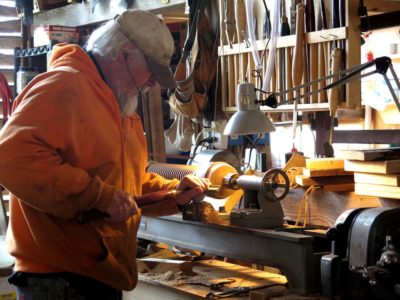
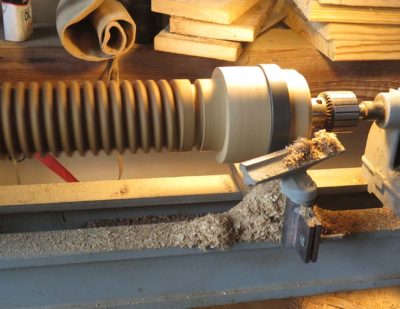
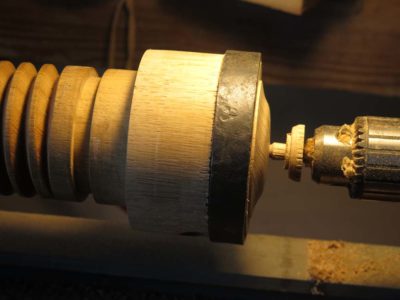
To reduce the number of times I whacked it with said knee I tossed the vise screw in the lathe and cut down the outer terminus block by an inch in length, moving the wrought iron collar right up against the handle holes and shaping the end, yielding a result much more to my liking than the knee-cruncher originally made. In fact completing this feature was one of the motivating reasons behind the move.
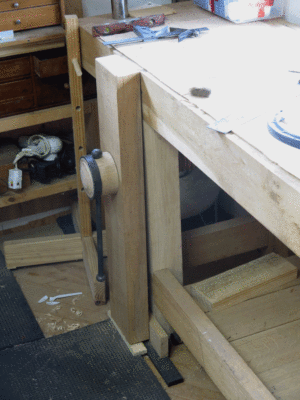
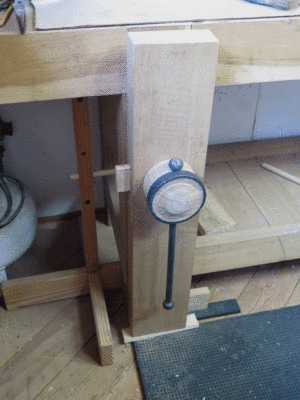

Using an outrigger stand temporarily until I get the sliding deadman built the bench works just like it is supposed to.
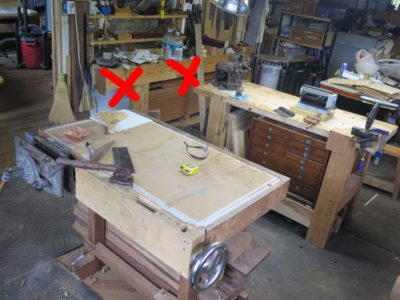
The integration of the massive Roubo into the workspace has other meaningful implications as well, almost like the ripples radiating from a stone being tossed into the pond. Not the least of these effects is the rendering of the planing beam as redundant, clearing up that particular space in the not-too-distant future. I may use part of that space as home to the full-service standing tool cabinet I have always wanted. If so I will have to find a new home for the exquisite vintage mahogany I have stored underneath the beam. Some of the other re-arrangeritis is more subtle as I will build a small, low Roubo bench for the space where the giant Roubo bench used to be. This lower bench will allow me to work for long stretches while sitting. As I get older I find the Eastern tradition of working while sitting down is all the more attractive; I actually do not mind working while standing, it’s the bending up-and-down that wears me out.
All things considered I am thinking that these changes will result in higher shop production-ableness while reducing the total footprint of the space.
Stay tuned.
With some of my major time-gobblers finished or at least with the ends in sight — the gunsmithing partner’s workbench, the cedar siding, refinishing the dining chairs, the book manuscript (still a lot to do but at least the train is moving steadily down the tracks) — I am refocusing on a small handful of interests in the shop, including my efforts to replicate Asian lacquerwork.
I am noticing that with increasing age my general allergy sensitivity is getting worse so I am not likely to try using genuine urushi, it being the refined sap of a poison sumac tree and all. It is not impossible, but unlikely given the toxicity of the emulsion. Still the performance of the final finish is such that it has been the theoretical model of “the perfect finish” for decades or even centuries. Anything that can be applied and polished to a mirror surface while being impervious to anything other than boiling nitric acid or long term UV degradation is a finish to not disregard entirely.
My allergic sensitivity is being driven home this year as we had a late, cold, wet spring (we had snow flurries three weeks ago!) so the “early pollen” and the “late pollen” are emerging back-to-back, resulting in the Mother of All Sneezefests. I’ve been breathing through jello for almost a week now with the resultant gurgling loveliness. Rather than compounding my miseries with liquid poison ivy (the same toxic allergen, urushiol, is present in poison sumac, poison ok, poison ivy, and mango skin) I am instead going to be employing a variety of alternatives to accomplish “fauxrushi” objects.
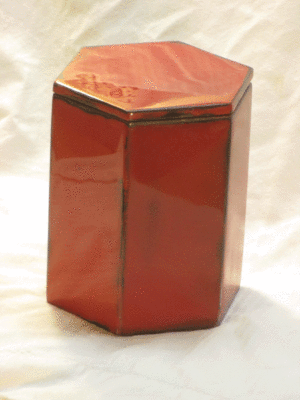
I have already written about West System 105 Epoxy and the variations of their catalysts as the basis for my fauxrushi (Popular Woodworking April 2017) and I am currently looking at three different polyester compositions as a test comparison. Polyester is reputed to be tougher and harder than epoxy but I have never used it for anything other than laying fiberglass fabric. It does have the distinct disadvantage of being much stinkier that West Epoxy but that is not an insurmountable problem.
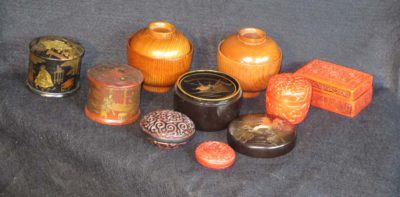
My little menagerie includes Asian lacquered pieces ranging from contemporary to probably 17th/18th C, and 19th C English japanned paper boxes (the two round pieces on the left).

I think this is my oldest piece, it is certainly the most complex. Red and black urushi are applied in alternating layers and then carved to reveal the layers. Urushi work is dominated historically by those two colors with the occasional blue piece with other colors even more scarce.
From time to time I pull out my own meager collection of genuine lacquerwork for inspiration and instruction, and delve into my library on the subject. These sources spur me on to explore this art form, and when the resin base, whether epoxy, polyester, or even urushi, is combined with silver, gold, ad pearl, the sublime can emerge under the eye and hand of a master. I am hampered by the near-complete absence of artistic talent but I nevertheless intend to stride down this path either until I lose interest (unlikely) or simply cannot physically do the work. My hands are still steady so I am hoping it will be a long journey.

This modern bowl has a molded fabric core, and remains one of the most beautiful artworks I have ever seen.

The conceptual foundation of this saw is the ability to rotate the saw blade within the saw frame. When noodling the design and fabricating this hardware element I considered many options before settling on something nearly identical to Roubo’s.

I ordered a variety of of sizes and configurations of eyebolts from McMaster-Carr to play with.
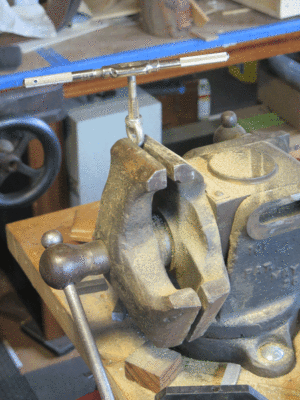

The eye large enough to accommodate or incorporate the 1/2″ cylindrical rod for affixing the blade was simply too huge for the proportion to work properly. The eye of the correct proportion was made for a threaded rod way too small for the 1/2″ wide blade. In the end I took that smaller eye and drilled and tapped it for the cylinder rod of the right size.


I split the eye bolt with my jeweler’s saw and a #10 blade. I then drilled the cross-holes through which the blade could be attached to this split rod.
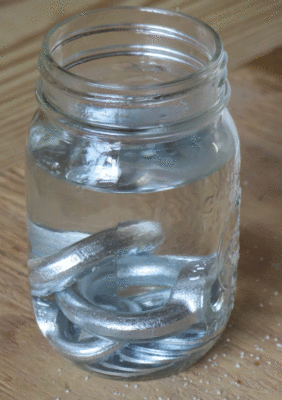
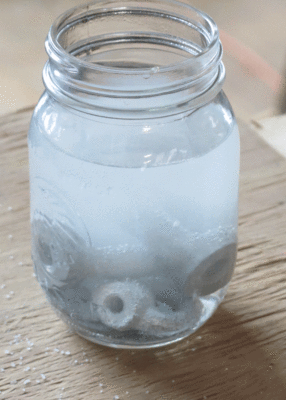
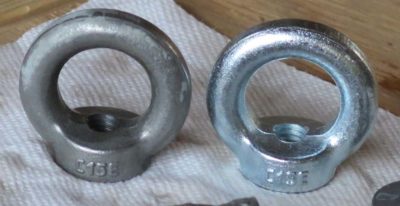
One of the last things I did before assembling the whole saw was to de-zinc the hardware parts by soaking them in a citric acid solution (about 2 tsp/pint of water). As soon as the mild acid began to work on the zinc the solution got cloudy. I had to monitor the progress and removed the hardware when I had gone far enough.

I assembled everything to make sure it fit but I did not give the saw a test drive since I did not have the saw blade that would be used for it.

I disassembled it and shipped it off to Wisconsin. I cannot wait to get a production prototype back to give it workout.





















































Recent Comments